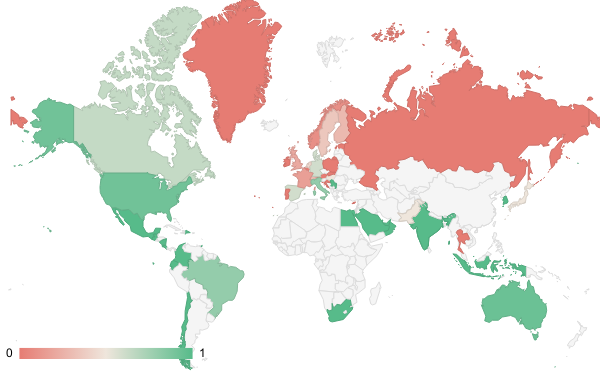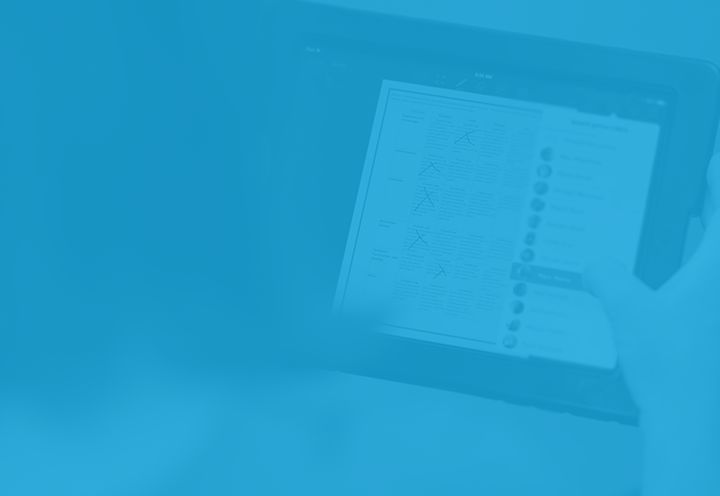COVID and the Classroom: A Global Perspective
On September 2nd 2020, Showbie sent a “How are you going back to school?” survey asking teachers for non-anecdotal data on their current learning mode in light of Covid-19. A total of 732 participants across 41 countries responded, with over 65% of participants located in the USA, UK, and Norway. We grouped results on a country-basis, and were able to achieve a greater level of granularity with the United States.
Participants of the first survey were asked for follow-up in a second survey sent on September 12, 2020. 64 participants shared how their school is conducting learning, their school’s COVID plans if an outbreak occurred, their fears and anxieties about the way they are returning to school, and what they are most proud of as an educator in this environment.
High cases of Covid-19 correlates with higher instances of distance learning
As seen in Figure 1, most countries in Europe, Singapore, and Greenland, have returned to the classroom. Countries such as the United States, Mexico, India, South Africa, Brazil, and Saudi Arabia, are conducting learning mostly through distance or a hybrid model. When we compare this to Figure 2, it is evident that some of these aforementioned countries (the United States, India, and Brazil), tend to be areas that are suffering the highest cases of Covid-19 to date. We can see that Covid-19 has impacted countries to various degrees globally and there is evidence to suggest that those hardest hit are not necessarily in brick-and-mortar classrooms.
In Figure 3, the Covid-19 case count globally will exclude the US, Brazil, India, and Russia as altogether their case count makes up >60% of global covid-19 cases and act as outliers in our dataset, minimizing the differences among the other countries of interest. When this has been accounted for, these correlations are more obvious. Countries like Mexico, Spain, Indonesia, and Saudi Arabia are other examples that confirm the positive relationship between high cases of Covid-19 and more schools adopting remote/hybrid learning modes.
The inverse is also true. Countries with low Covid-19 cases, such as Greenland, Ireland, Portugal, Thailand, and Poland, have a low Covid-19 case count and are exclusively in the classroom.
If we take a granular view of the United States and Europe, the relationship between the number of Covid-19 cases and learning mode is clear. In Figure 4, we can see that most of the country is remote or hybrid with the exception of Utah, Tennessee, and Nebraska (the states in white denote areas we did not receive data from). As seen in Figure 5, most states in the US are experiencing high cases of Covid-19 with the scale starting at 1.7K cases in Vermont. Figure 6 and 7 show this correlation between case count and adoption of remote/hybrid learning in Europe. Other socio-economic variables are at play so it is important to point out there will be exceptions such as the United Kingdom, France, and Russia.
Figure 1. Countries using a primarily remote/hybrid learning mode represented on a scale of 0 (100% completely in the classroom) to 1 (100% using remote/hybrid learning). Dark shades of green indicate countries with a higher portion of schools using remote/hybrid learning, while a deep red colour indicates the inverse.
Figure 2 (LEFT). COVID-19 case count by country. Black indicates countries with a higher count of covid cases while a light grey colour indicates the inverse. Data pulled on September 24, 2020 2:00 p.m. MDT from John Hopkins University CentRE for Systems Science and Engineering.
Figure 3 (RIGHT). COVID-19 case count by country (exclude US, Brazil, India and Russia). Black indicates countries with a higher count of covid cases while a light grey colour indicates the inverse. Data pulled on September 24, 2020 2:00 p.m. MDT from John Hopkins University Center for Systems Science and Engineering.
Figure 4 (Left). US States using a primarily remote/hybrid learning mode represented on a scale of 0 (100% completely in the classroom) to 1 (100% using remote/hybrid learning). Dark shades of green indicate countries with a higher portion of schools using remote/hybrid learning, while a deep red colour indicates the inverse. The white spaces are areas we did not receive data from.
Figure 5 (Right). COVID-19 case count by US State. Black indicates states with a higher count of covid cases while a light grey indicates a lower case count. Data pulled on September 24, 2020 2:00 p.m. MDT from John Hopkins University CentRE for Systems Science and Engineering.
Figure 6 (Left). European countries using a primarily remote/hybrid learning mode represented on a scale of 0 (100% completely in the classroom) to 1 (100% using remote/hybrid learning). Dark shades of green indicate countries with a higher portion of schools using remote/hybrid learning, while a deep red colour indicates the inverse. The white spaces are areas we did not receive data from.
Figure 7 (Right). COVID-19 case count by country In europe (exclude Russia). Black indicates countries with a higher count of covid cases while a light grey indicates a lower case count. Data pulled on September 24, 2020 2:00 p.m. MDT from John Hopkins University CentrE for Systems Science and Engineering.
The Teacher Perspective: What does this look like?
In the second survey, teachers gave greater insight into the action surrounding these numbers. For those that returned to school, they mentioned some schools were wearing masks, physical distancing, using staggered times for different classes, and tables and surfaces were being disinfected after every lesson.
Some schools that have returned to the traditional learning format, have options where students and families can elect virtual learning, or they learn virtually due to illness or quarantine. Peadar McLoughlin from St Colmans College (Armagh, UK), has returned to the classroom, but revealed “already, absences are increasing but absent pupils are using Showbie to stay up-to-date with their learning”. Gavin Holden from Abbot Beyne School (Burton-On-Trent, UK), is preparing for this scenario:
“All resources [are] being posted in Showbie for every lesson in case individual students or larger cohorts have to isolate at home and access work remotely”.
Edu-tech platforms are known for their paperless interactions which reduce cost and their environmental footprint. Businesses have recently led a paperless movement to prevent the possible transmission of Covid-19, and some classrooms have embraced edu-tech platforms, like Showbie, for this reason. A teacher from Edinburgh Academy Junior School (Edinburgh, Scotland), shared that:
“All children are back in school full time, with much of the work being uploaded to Showbie in order to minimize teacher contact with physical notebooks.”
Janis Watson from Harrogate Grammar School (Leeds, UK), is also using Showbie, “but with a focus on using it more to avoid handing out paper to the students.”
Over 55% said their school plans to go remote if an outbreak happens
Teaching remotely was the most common plan when asked what their school would do if an outbreak occurred at their school. 20% said their school opted for a hybrid approach while 15% of respondents mentioned their school had no or vague plans. Some teachers that have returned to the classroom proposed that affected classes/group levels would quarantine and learn remotely, which would hopefully avoid an entire school shutdown. Stanislav Halfar from ZŠ a MŠ Bolatice, Czech Republic, has started “preparing for the distance learning” despite being in the classroom.
Schools that are currently remote kept their Covid-19 School plans brief, as the virus is closer to home. John Barrett from Pleasant Plains CUSD8 (Sherman, USA) revealed that “we are fully remote, so an outbreak will not negatively impact us”. A couple of states over, Ms. Netzley from Granada Hills Charter High School (Reseda, USA) is in a similar position:
“We are completely online the entirety of the first semester. We are discussing Hybrid plans for second semester, and possible COVID outbreak scenarios”.
Fear of contracting Covid-19 tops the list of back-to-school anxiety
Increased risk of infection dominated back-to-school anxiety (40%) in the anecdotal responses, closely followed by concern for the well-being of students, staff, and family members (30%). Apart from health-related concerns, 19% of teachers were also apprehensive that the virtual classroom could foster a strong sense of community and connection that the traditional classroom offers.
Other common themes highlighted that teachers are feeling overwhelmed and tired from the constant changes, and are finding it takes time to digitize their work for the virtual model. One teacher from First Assembly Christian School (Tennessee, USA) shared that:
“I’m afraid that the kids are more tech-savvy than I am, and they may not take their education seriously if I make things too simple”.
Teachers are proud of their technology use and adoption
Overwhelmingly, over 60% of responses revealed teachers are embracing technology in the Covid landscape and this has become a source of great pride. In their own words, they have taken “on the challenge” (David Colby from Instituto Moderno Americano, Mérida, Mexico) and are proud of what they and their fellow staff have achieved. A teacher from Judson High School, San Antonio (USA) praised, “how every teacher embraced and succeeded in learning three new platforms in two weeks”. Despite the challenges that come with edu-tech platforms, Stacie Allen from Sunnyvale (USA) pointed out that “[it] is ultimately helpful for students and teachers”.
These responses tended to overlap with another overarching theme, that they experienced a sense of gratification in supporting and engaging students (55%). Furthermore, teachers reported seeing the value of technology in reaching pupils disadvantaged by barriers of physical location or absenteeism, with Brett Webber from (Milpitas High School, Milpitas, USA), stating he “had better attendance now, than when we were in person”.
Covid-19 has changed the delivery method of education. Areas that have been hit the hardest by the virus, are learning through remote/hybrid modes and are awaiting the chance to return to the classroom. The value of edu-tech platforms is not only obvious for distance learning, but continues to play an important role in delivering resources to absent or quarantined pupils, preparing for future outbreaks, and minimizing contact between teacher-and-student. Technology adoption has come with its own set of challenges but it became its own learning opportunity and a source of pride for teachers.
We will end with a quote from Teacher, James W (Bakersfield, USA):
“I am proud of the support of our entire school community: the parents, the administration, fellow teachers, and the students. Everyone has been working hard together to provide as normal of an education as possible for our youth.”






